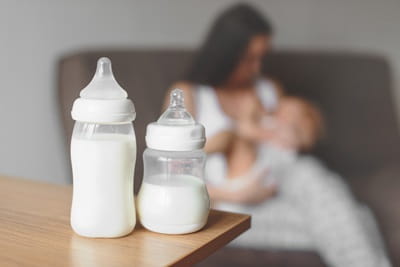Self-Care for the Breastfeeding Mom

You know all about the benefits of breastfeeding—and there are lots of them. But, you may not have expected some of the more uncomfortable aspects. Taking good care of your nipples will help prevent painful issues down the road.
Hygiene
You may not know this, but your nipples (especially during lactation) are designed to keep themselves clean and healthy, without any action on your part. Have you noticed those little bumps around the areola (the flat part of your nipple)? Those are known as “Montgomery Glands,” and they produce a substance that cleans and lubricates your nipples. Although you should rinse your breasts with water each day in the shower, you should avoid the use of soaps or fragrances on your nipples.
Leakage
Sometimes, despite baby’s best efforts, your breasts become so full of milk that they leak. And, for some of us, we just leak all the time no matter how often baby nurses. You’ll want to invest in some good nursing pads, either disposable or washable, and change them often. Soaked nursing pads can be a breeding ground for nasty bacteria or even yeast.
Common Nipple Nuisances
- Nipple soreness is one of the top complaints of breastfeeding mothers. If yours are unbearably painful during feeding, or if blisters are developing, you may need to take another look at how your baby is latching on. If your nipple isn’t deep inside baby’s mouth, it won’t be comfortable for you, and baby won’t get as much to eat. A quick call to a lactation consultant could provide an instant fix.
- Cracked nipples is another painful condition, when the nipples become too dry and the skin actually begins to crack, and sometimes bleed. It’s okay if baby ingests a little blood with his milk, but it’s not okay for you to be in constant pain. To help cracked nipples heal, you can rub a few drops of your own milk onto your nipples after each feeding. Pure lanolin, which is marketed and sold just for moms’ nipples, also works really well to promote healing. A good airing out can be beneficial, too—just undo your nursing bra and let those nipples breathe.
- Breaking the latch. When you’re ready to end a feeding, but baby hasn’t fully let go of your nipple, there’s a right way and a wrong way to detach him. The wrong way involves pulling your breast until your nipple comes out of baby’s mouth with a POP! That really hurts. The right way is to put your finger just inside the corner of baby’s mouth to break the seal, and then you can easily and painlessly put your breast away for later.
As always, if you have questions or concerns about caring for your nipples, talk to your health care provider or a lactation consultant for information and advice.
